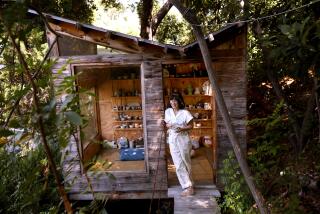Shattering a Theory on Chinese Porcelain : * Archeology: Altadena researcher’s book says mass production of distinctive blue and white pieces took place earlier than thought. But some experts are skeptical.
- Share via
Once his book is published, Adam Kessler may be regarded as a bit of a bull in the china shop.
Or, more specifically, as a maverick in the world of antique Chinese blue and white porcelain.
The 33-year-old Altadena archeologist has written a book advancing the theory that the earliest mass production of blue-and-white porcelain pieces took place far earlier than is commonly supposed.
Most scholars believe the major production occurred in the late 13th and 14th Century Yuan Dynasty, but Kessler argues it started 200 years earlier, during the Song Dynasty, also called the Sung Dynasty.
Kessler, a UCLA postdoctoral research fellow, has written his book, “Song Blue and White Porcelains on the Chinese Silk Route,” in collaboration with “Sammy” Yu-Kuan Lee. Lee, 89, is a Tokyo-based lay scholar and retired art dealer whose family is a major benefactor of the Sammy Yu-Kuan Lee Gallery (of) Far Eastern Lacquers at the Los Angeles County Museum of Art.
Kessler and Lee base their conclusions mainly on a review of ancient Chinese records, which they say show the vessels were mass produced to be used as diplomatic gifts far earlier than most experts realize.
The pieces--some delicate and exquisite, others thick and bold--consist of vases, jugs and small cups, as well as incense burners and large plates used for feasting. The blue paintings on white ground sometimes tell of dragons and dreams.
Locally, some antique blue-and-whites can be seen at the Pacific Asia Museum in Pasadena and the Los Angeles County Museum of Art.
Kessler and Lee acknowledge their work is of limited interest to the general public and casual collectors; if anything, it would make blue and white pieces more valuable, not less, if they were deemed to be older. But they believe their findings could be a bit of a bombshell in the small, rarefied world of antique Chinese art dealers, curators and historians.
“To acknowledge our findings,” Kessler said, “would force specialists to reconsider their dating criteria, which would put their reputations on the line.”
David Kamansky, executive director of the Pacific Asia Museum, was skeptical about the contentions advanced by Kessler and Lee.
“There’s no question that the major production (of blue-and-whites) occurred from the late 13th Century onward,” Kamansky said. “I would be very surprised otherwise.”
“What they propose is an hitherto historically unexpected phenomenon,” said another Asian art expert, who asked to remain anonymous. He termed their thesis “most controversial.” If borne out, however, he acknowledged their findings “would be a major contribution to the history of blue-and-whites in China.”
Bruce Coats, a professor of Asian Art History at Scripps College in Claremont, said he would keep an open mind. “I’m not a ceramics specialist, but as more and more tombs are being opened up, a lot of dating is being changed. I would not be surprised.”
And at UCLA, Hung-hsiang Chou, an associate professor of East Asian languages and culture who was Kessler’s thesis adviser, said the evidence in the book is “very strong.”
Within the next six months, the authors intend to submit their work to academic presses for publication in Chinese and English.
Although he has no college degree, Lee has written three books on antique Chinese ceramics, carpets and lacquerware.
His association with Kessler began in 1980, when Kessler, then studying toward a master’s degree in Chinese ancient history at the University of Chicago, learned of Lee’s self-taught expertise in antique Chinese art objects. He eagerly sought an introduction and first met Lee--scion of an old Beijing textile and carpet manufacturing family--in 1981, at the Pasadena home of Lee’s son, where Lee was staying at the time.
When Lee is in the United States nowadays, he often spends hours with his colleague in Kessler’s Altadena home, spreading wads of research papers out in the study while they discuss and argue over source material.
Differences in age and background seem to vanish in the face of their intellectual bonding. Kessler and Lee are often seen, speaking together in Chinese, at The Fox’s Dining Room, an Altadena breakfast and lunch hangout. They make it a point to bring their intellectual wrangling over the delicate blue-and-whites into the crash and clatter of an American coffee shop.
“Very often, people see us engaged in fierce discussions and think we’re at odds with one another,” Kessler said, “but actually we’re the closest of friends.”





